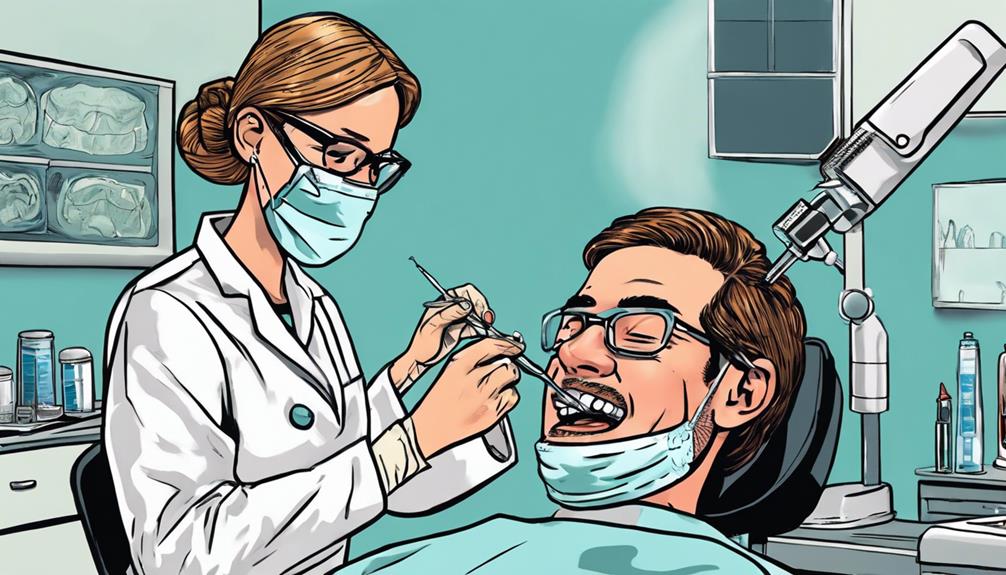To truly grasp what crown lengthening is, understand it's a surgery to fix gummy smiles and boost tooth appearance. It involves taking out extra gum and bone for better structure and gum health. The procedure shapes the gum line and bone, needing oral health checks and numbing medicine. After, expect some soreness and swelling, eased with pain meds and ice packs. Reasons range from gummy smile correction to prepping for crowns to fostering oral well-being. Embracing this process leads to improved smile aesthetics, healthier gums, and correct tooth alignment. Keep exploring for more in-depth insights.
Key Takeaways
- Crown lengthening reshapes gum line and bone, improving smile aesthetics and treating periodontal issues.
- Procedure involves removing excess gum tissue and bone, requiring local anesthesia.
- Benefits include enhanced gum tissue health, improved smile aesthetics, and proper tooth alignment.
- Ideal for correcting gummy smiles, restoring damaged teeth, and preparing for dental crowns.
- Recovery involves caring for the area, using prescribed pain meds, and maintaining oral hygiene.
Definition of Crown Lengthening
Crown lengthening is a surgical procedure that removes excess gum tissue and bone to expose more tooth surface. This process is essential for various dental reasons, including correcting a gummy smile, improving tooth structure, and treating periodontal disease. By reshaping the gum line and bone level, crown lengthening can enhance both the aesthetics and functionality of your smile.
During the procedure, your dentist will start by evaluating your oral health and giving local anesthesia to guarantee your comfort. Next, precise incisions are made along the gum line to access the underlying tissue and bone. The excess gum tissue and bone are then carefully removed to reveal more of the tooth's surface, allowing for proper alignment and support for dental restorations like crowns.
After the surgery, you may experience mild soreness and swelling, which can be managed with pain relievers and ice packs.
Crown lengthening offers numerous benefits, such as creating space for dental crowns, supporting overall dental health, and enhancing the aesthetics of your smile.
Reasons for Crown Lengthening

For various dental issues, the surgical procedure of crown lengthening is recommended to address specific concerns related to tooth structure and gum health. Crown lengthening serves multiple purposes, such as restoring damaged teeth, correcting gummy smiles, preparing for dental crowns, and enhancing aesthetic appearance. By creating more visible tooth structure, this procedure can improve your oral health and overall smile aesthetics.
| Reasons for Crown Lengthening | ||
|---|---|---|
| Correcting gummy smiles | Restoring damaged teeth | Enhancing aesthetic appearance |
| Preparing for dental crowns | Improving oral health | Creating space for restorations |
Crown lengthening is not only beneficial for your oral health by improving gum tissue health and creating space for dental restorations but also enhances your smile's aesthetic appearance. After the procedure, following post-operative care instructions, including pain management and using antimicrobial mouth rinse, can help in the healing process over 2-3 months, ensuring successful outcomes.
Procedure Overview

During the crown lengthening procedure, your dentist will remove excess gum tissue and bone to expose more of your tooth's surface. This process helps correct issues like a 'gummy smile' and provides room for dental restorations.
The benefits of crown lengthening include improved gum tissue health, enhanced smile aesthetics, and proper tooth alignment.
Crown Exposure Process
Exposing more of the tooth's surface involves a surgical procedure that includes removing excess gum tissue and bone. This crown exposure process is essential for various reasons, such as correcting a gummy smile, enhancing tooth structure for restorations, and addressing periodontal issues. Here are some key points to understand about the crown lengthening procedure:
- Purpose: Crown lengthening procedures aim to improve the aesthetics of your smile by adjusting the gum line and removing excess soft tissue.
- Steps: During the process, incisions are made along the gum line, excess tissue and bone are carefully eliminated, and the area is then sutured for proper healing.
- Aftercare: Local anesthesia is commonly used to minimize discomfort during the procedure, with any post-operative soreness and swelling managed using pain relievers and ice packs.
Benefits of Lengthening
To understand the benefits of crown lengthening, it's important to recognize how this procedure positively impacts both the aesthetics and functionality of your smile.
By exposing more of the natural tooth structure, crown lengthening enhances the overall appearance of your smile, making it more balanced and visually appealing. If you struggle with a gummy smile or an uneven tooth-to-gum ratio, this cosmetic procedure can help correct these issues, giving you a more confident smile.
Additionally, creating space for dental crowns and other restorative procedures through crown lengthening not only improves the aesthetics of your smile but also contributes to better oral health. This procedure can enhance the symmetry of your upper teeth, transforming your smile in a way that boosts your self-esteem.
Through the removal of excess gum tissue, crown lengthening works wonders in revitalizing your smile and giving you a reason to show off your teeth with pride.
Pain Management During Crown Lengthening

Utilizing local anesthesia is essential for managing pain effectively throughout the crown lengthening procedure. This helps in reducing discomfort both during and after the surgery.
Here are some key points to keep in mind for pain management during crown lengthening:
- Local anesthesia: Administered to minimize pain during the procedure.
- Pain relievers: Prescribed to alleviate any post-operative discomfort.
- Ice packs: Applied to reduce swelling and soreness in the treated area.
After the crown lengthening procedure, you may experience mild soreness and swelling. Following the dentist's instructions on taking pain relievers and using ice packs can help in managing these symptoms effectively.
Additionally, if prescribed, make sure to take any pain medications as directed to guarantee a comfortable recovery process. Remember, proper pain management is essential for a smooth post-operative experience.
Results and Recovery Process

Following crown lengthening, it's crucial to see longer-looking teeth as an immediate result.
The recovery process, which lasts 2-3 months, involves caring for the affected area, managing swelling and discomfort, and maintaining proper oral hygiene.
During this time, it's important to follow post-operative instructions diligently, take prescribed pain medication as needed, and be mindful of what you eat to support healing.
Procedure Aftermath and Care
Following the crown lengthening procedure, you'll notice immediate results, with the complete recovery process typically lasting 2-3 months. During this time, it's essential to take proper care of your oral health to guarantee ideal healing.
Here are some key points to keep in mind:
- Use any prescribed pain medication to manage post-operative discomfort effectively.
- Incorporate antimicrobial mouth rinse into your daily routine to prevent infections during the healing period.
- Make sure to keep the surgical site protected with intraoral bandages to aid in the healing process and minimize any potential complications.
Taking these steps will assist in a smooth recovery and promote the best outcomes from your crown lengthening procedure. Remember to follow your dentist's instructions carefully and attend any follow-up appointments to monitor your progress. Your commitment to aftercare is vital for a successful recovery.
Swelling and Discomfort
Managing swelling and discomfort is an important aspect of the recovery process following crown lengthening surgery. Swelling, a common occurrence post-procedure, usually reaches its peak within 24-48 hours.
To alleviate discomfort, your dentist may prescribe pain medication and recommend using cold compresses on the affected area. The swelling and discomfort should gradually diminish over the course of a few days as your healing process progresses.
It's essential to adhere to the post-operative care instructions provided by your dentist to help minimize swelling and discomfort. By following these guidelines diligently, you can aid in a smoother recovery and promote optimal healing.
Remember, it's normal to experience some level of swelling and discomfort after crown lengthening, but with proper care and attention, you can help manage these symptoms effectively.
If you have any concerns or experience excessive swelling or prolonged discomfort, don't hesitate to contact your dental provider for further guidance and support.
Eating and Oral Hygiene
Maintaining proper oral hygiene and adjusting your diet are essential aspects of the recovery process after crown lengthening surgery. To guarantee a smooth healing journey, follow these guidelines:
- Soft Foods: Opt for easy-to-chew options like yogurt, mashed potatoes, and smoothies to minimize discomfort while eating.
- Avoid Hard Foods: Steer clear of hard, crunchy, or spicy foods to prevent any irritation or damage to the surgical site during the healing phase.
- Oral Hygiene: Brush your teeth gently and use the prescribed mouthwash to keep the surgical area clean, reduce the risk of infections, and promote healing.
Importance of Crown Lengthening

Understanding the importance of crown lengthening in dental procedures is essential for achieving the best oral health and aesthetics. Crown lengthening plays a pivotal role in correcting a gummy smile by exposing more of the tooth structure. This procedure helps create a harmonious balance between the teeth and gums, leading to improved smile aesthetics.
Additionally, crown lengthening is commonly employed to prepare the mouth for restorative treatments such as dental crowns. By providing adequate space for dental crowns, the procedure not only enhances the functionality of the teeth but also contributes to overall appearance.
Furthermore, crown lengthening greatly improves smile aesthetics by correcting a gummy smile and enhancing the tooth-to-gum ratio. The procedure allows for a more proportionate and pleasing smile, boosting confidence and self-esteem.
Therefore, if you're looking to enhance your smile aesthetics and ensure the longevity of dental restorations, crown lengthening is a crucial step in achieving excellent oral health and a beautiful smile.
Candidates for Crown Lengthening

Candidates for crown lengthening procedures typically include individuals with a gummy smile, insufficient tooth structure, or those requiring space for dental restorations. If you fall into any of these categories, you might benefit from this dental treatment for various reasons.
Here are some key factors that make someone a suitable candidate for crown lengthening:
- Gummy Smile: Individuals with excessive gum tissue that covers a significant portion of their teeth may seek crown lengthening to reveal more of their tooth structure.
- Inadequate Tooth Structure: Patients with short teeth might opt for crown lengthening to enhance the aesthetic appearance of their smile.
- Need for Dental Restorations: Those requiring dental crowns or bridges may undergo crown lengthening to create the necessary space for these restorative procedures.
Finding a Crown Lengthening Specialist

When seeking a specialist for crown lengthening, prioritize finding a periodontist with expertise in this specific procedure. It is crucial to consider the experience of the crown lengthening specialist in performing such intricate dental surgeries. Additionally, checking patient reviews and testimonials can provide valuable insight into the outcomes of their crown lengthening procedures. Ensure that the specialist utilizes advanced techniques and cutting-edge technology to ensure precise and effective results. Seeking referrals from your dentist or healthcare provider can also lead you to a trusted crown lengthening specialist who has a proven track record of success.
| Considerations | Description |
|---|---|
| Specialist Expertise | Look for a periodontist specializing in crown lengthening procedures. |
| Experience | Prioritize specialists with extensive experience in performing successful crown lengthening. |
| Patient Reviews | Check testimonials for insights into previous patients' outcomes post-crown lengthening. |
| Advanced Techniques | Ensure the specialist uses advanced techniques and technology for precise and optimal results. |
Frequently Asked Questions
What Are the Different Types of Crown Lengthening?
There are different types of crown lengthening procedures. They include esthetic crown lengthening for smile enhancement, functional crown lengthening to support dental restorations, surgical crown lengthening to remove excess tissue, and orthodontic crown lengthening for alignment correction.
What Is the Code for Crown Lengthening?
The code for crown lengthening is D4249. It represents surgical crown lengthening. Use it for billing and record-keeping. This code guarantees accurate documentation and billing for crown lengthening procedures, enhancing practice transparency and efficiency.
What Are the Disadvantages of Crown Lengthening?
When considering crown lengthening, be aware of potential risks like temporary sensitivity, infection, discomfort, bleeding, and swelling. Following proper post-operative care is essential for the best healing and results. Consult your dentist for personalized guidance.
Is Crown Lengthening Really Necessary?
Yes, crown lengthening is necessary for various dental reasons such as correcting a gummy smile, restoring damaged teeth, and preparing for dental crowns. It improves oral health, aesthetics, and guarantees proper tooth alignment.
Conclusion
To wrap up, crown lengthening is a straightforward procedure that can help you achieve a perfect smile. By understanding the reasons for crown lengthening, the procedure overview, pain management options, and the recovery process, you can make an informed decision about this treatment.
Remember, finding a qualified specialist is vital for successful results. So, take the time to research and choose the right professional for your crown lengthening needs. Your smile will thank you!









